![]()
Silver (Lagrimas de la Luna)
Adam Hamilton September 8, 2000 3988 Words
“We will drink chicha from your skull, from your teeth we will make a necklace, from your bones we will make flutes, from your skin we will make a drum, and then we will dance.” – Ancient Incan popular rhyme describing the fate of those who opposed Incan might.
The ancient Incan empire was the largest and most advanced empire in the Americas before it was “discovered” by the Europeans. Originally a Peruvian highland tribe, the Incas spread through campaigns of conquest until the empire in the fifteenth century almost rivaled the size of the classical Roman Empire. Unlike the colorful quote above, the Incans actually typically allowed conquered tribes to live in peace, and they were usually agreeable masters. The Incans were incredibly technologically adept, and they developed great urban centers, a road network that stands to this day, amazing administrative acumen, and achieved remarkable skills in metal mining, refining, and working. Like most of the cultures of the Americas, the Incan religion relied on human sacrifice to appease its various deities. Although not as bathed in blood as their Aztec neighbors to the north, sacrifices were still an important pillar of Incan faith. It was considered a great privilege to be sacrificed, as only the physically and mentally best of the people were allowed the honor of dieing for their god. The sacrificial victims were laden with silver and gold, and dispatched to eternity in various creative ways. Beautiful gold and silver jewelry was carefully created for these ceremonies with unparalleled craftsmanship. To the Incas, gold was known as the “Sweat of the Sun” and silver as the “Tears of the Moon”. When the Spanish conquistadors arrived to loot the empire for Spain, they were awestruck at the amount of silver and gold the Incan empire had accumulated. The Spanish appropriated the romantic name “Tears of the Moon” for silver, which translated into “Lagrimas de la Luna” in their native tongue.
Silver was incredibly important all over the ancient world, not just the Americas. As hefty amounts of ore must be processed to refine silver in quantity, the majority of the ancient silver was likely a byproduct of copper smelting. The ancient Greek empire, however, long before the Roman and much later Incan civilizations, actually grew to power through specialized primary silver mining. Around the sixth century BC, silver was mined in increasing quantities a few dozen miles south of Athens in the Laurion district. Although the mines had been around since the Bronze Age, the Athenians increased production and used the silver to finance the city-state’s rise to power. In 580 BC, they minted their first silver coin, the famous Athenian drachma. Without the Laurion silver mines, Athens would have lacked the funds to start an empire. Some historians believe an incredible 160 million ounces of silver were produced from the mines! Even the citizens of Athens had shares in the silver mining operations, and everyone had a vested interest in an uninterrupted supply of silver to finance the civilization. In 512 BC, the Persians invaded northern Greece and conquered other key Athenian silver mines in the north. In the battle of Marathon in 490 BC, the Greeks routed the Persians to reclaim part of their silver supply, but they knew another campaign was inevitable. After convincing the populace to forgo normal silver dividends, the Athenian leadership used silver mining proceeds to finance construction of one of the first large navies, eventually exceeding 130 ships. When the Persians returned a decade later under the personal command of the brilliant tactician and conqueror King Xerxes, they destroyed the Greek army at Thermopylae and marched south to raze Athens. As Athens burned, the Greeks’ new navy fortunately remained intact and they were able to sink the Persian fleet at Salamis necessitating another Persian retreat from Greece. Athens’ fortunes waxed and waned with the fate of its silver mines. A few decades later, Athens fell in the Peloponnesian wars as the bountiful silver mines of Laurion were shut down by a brilliant maneuver by their rival Spartan army. The playwright Aeschylus had called Laurion the “treasure house of the country”, and the Spartans, knowing this, set up military camp between Athens and its mines rather than heading home for the winter. Thucydides chronicles the resulting chaos, as the dwindling silver supply and chronic shortage of money led to the Athenians losing the Peloponnesian wars. Without silver, classical Greek thought, the basis for much of our modern western civilization, may never have developed.
Almost two and a half millennia later, silver is still an important commodity in our modern world. There are a myriad of contemporary uses for silver, including general industrial applications, photographic applications, and jewelry and silverware. New silver alloys with aluminum and titanium and lithium are among the strongest metals known, and are used extensively in demanding aerospace and military applications. The holy grail of high temperature superconductors will likely be discovered through creative applications of silver. Silver has crucial properties necessary for the highly sought after frictionless transmission of electricity, and is used extensively today as an electrical conductor in all kinds of high-technology devices. Silver is also an important industrial catalyst, vital for the production of many widely used products today, including certain types of plastics. New silver oxide batteries have twice the electrical energy storage density of comparable lead-acid batteries. The medical industry uses silver extensively, for everything from water and air purification to X-ray applications. The fascinating list of uses for silver goes on and on, and could easily fill a respectable sized tome.
For the potential investor the critical question regarding any investment is … is it OVER or UNDER valued at the moment? If silver is expensive, there is no sense investing in it. If it is cheap, however, there could be compelling opportunities for large profits in silver. In this essay we will attempt to answer this important silver valuation question, as well as briefly address silver supply and demand fundamentals. As always, history is the perfect place to launch our exploration. The following graph outlines the nominal price of silver over the last 30 years…
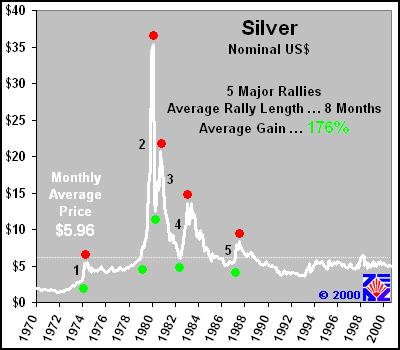
As an initial indicator of undervaluation, the monthly average closing price of silver since 1970 has been around $6 per ounce. Five major rallies in silver have occurred in the last three decades, concentrated around the great commodities boom of the early 1980s. These silver rallies lasted, on average, 8 months, and produced stellar 176% average gains. It is quite evident that each of the past rallies was VERY steep and fast, demonstrating the incredible speculative potential of the white metal. When silver jumps in price, it tends to move rapidly and decisively, producing very large gains for speculators. The second rally is particularly interesting. Although not evident in this graph, silver reached an intra-day high near $50 an ounce in early 1980. From its monthly low closing price of $1.32 in November 1971, the lagrimas de la luna saw an increase in price of over 37x! This kind of historical leverage is absolutely extraordinary, and even exceeds gold’s incredible run from $42 to $850 (20x) over the same time period. Historically, silver has been the most volatile and explosive of all the major metals. As we live in an age where the fiat money supply unfortunately multiplies like rabbits, the real modern history of silver prices remains obscured until we use inflation adjusted dollars for our analysis…
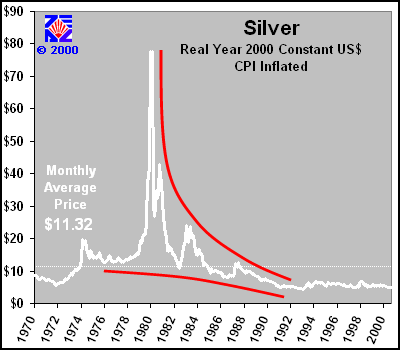
In inflation adjusted constant year 2000 dollars, silver reached a monthly closing high of $78 in late 1979. The intra-day $50 nominal high breached in early 1980 translates into an INCREDIBLE $110 in today’s weakened dollars! Silver has, from a real perspective, lost a massive 95% of its value in 20 years. It is beginning to look like a perfect contrarian play. The monthly average closing price of silver in real 2000 dollars is over $11. This indicates silver, currently languishing below $5, is trading at roughly 45% of where it has averaged over the last 30 years, currently far on the undervalued side of reality. The chart pattern above is also quite intriguing. The red lines marking the tops and bottoms create a kind of funnel, in which silver has spiraled around until collapsing into its maw. Like light trying to escape from the gravitational vacuum of a black hole, the silver price has not yet pulled out of this death spin. From 1991 to 2000, the chart looks kaput! One wants to pick it up and shake it to see if there are any broken parts bouncing around inside. From a contrarian perspective, this kind of multi-year distributive low is a very appealing sign. After an almost ten year real bottom in silver, the metal appears to have nowhere to run on the chart but north… As silver and gold have been historically correlated positively, a look at the white metal in a line up next to the king of assets is in order…
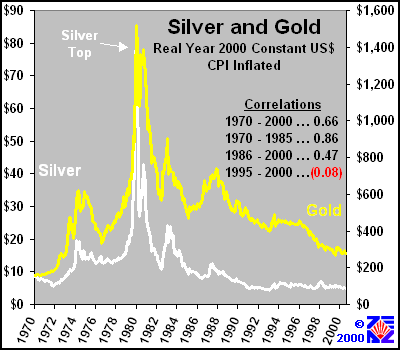
The above graph is also in constant 2000 dollars, as inflation has had a devastating affect on general American price levels in 20 years of bloated government largesse and is a crucially important variable to factor into investment decisions. The gold and silver lines on the graph further accentuate silver’s incredible volatility and leverage. In the gold spikes, note the broader flatter base of each rally. The rallies appear wider, develop more slowly, and take more time to rise and fall. Silver, on the other hand, tends to take off like a bullet once it is time to rally, with little or no warning in the form of gradually rising prices. Silver is the ultimate speculative play of the metals world, as vast gains accrue over a very short temporal span when the white metal gallops. The lines also emphasize the fact that silver in real terms has fallen much further than even the arch-nemesis and perpetually shorted enemy of global fiat currencies, gold, has stumbled since 1980. Over the whole 30 year event horizon encompassed above, the white and yellow metals have had a good positive correlation of 0.66. From 1970 to 1985, the metals had a very high correlation of 0.86. In high inflation environments, both gold and silver shine brilliantly, with silver providing returns exceeding gold when a major rally occurs. With crude oil trading above $35 per barrel, the broad commodities indices reaching multi-year highs, the M3 money supply growing at unfathomable rates as government discipline (an oxymoron) continues to wane, and Wall Street knowingly lying through its teeth that all is peachy regarding equity valuations, there is an incredibly high probability that we are plunging into a highly inflationary environment in the States. Barring a miracle, like a new gold standard being established (interestingly, dividing official US gold reserves by current M3 yields a gold price per ounce of a jaw-dropping US$25,778! … that’s right, PER OUNCE) higher inflation is virtually inevitable. From 1986 to 2000 the silver and gold correlation dropped to a noncommittal 0.47. From 1995 to 2000, the period when the gold carry trade and gold suppression agenda began in earnest, the historical correlation has actually turned slightly NEGATIVE, to –0.08. Yet another indicator of the continued perplexed surreality that consumes the global metals markets today…
As our quick and dirty historical perspective on silver yields indications of the metal being undervalued quite dramatically in historical terms, there is ultimately only ONE factor that will affect future prices of silver (or any commodity)… global physical supply and global physical demand. If supply exceeds demand, prices will drop. If demand exceeds supply, prices will rise. The academic discipline of economics has done a wonderful job distilling the infinite number of variables relevant to any market into a simple and eminently understandable intersection of supply and demand curves. The graph below outlines the global silver supply since 1990, and its constituent components…
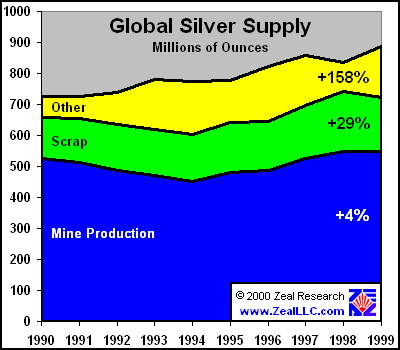
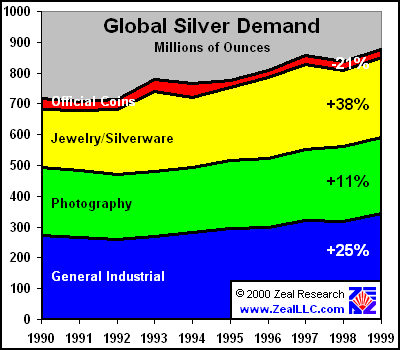
Although mined supplies of silver have flatlined over the last ten years, demand continues to grow in all major areas of silver consumption. The general industrial demand grew 25%, and, as mentioned above, promises to continue to grow in the future as new and innovative uses for the amazing properties of the metal continue to be discovered. This demand is very inelastic, meaning a rise in the price of silver will not affect this quantity demanded much if at all. The amount of silver used in a given device is very small, so silver constitutes a trivial cost per unit. Even a 1000% increase in silver prices will only result in a rise in price of most devices of mere pennies per unit, so this demand is unlikely to slacken and it will continue to grow into the foreseeable future. Definitely very bullish for the white metal! Photography is another very important use of silver, as the white metal is absolutely critical to conventional picture producing techniques. Silver halide crystals are suspended on film, and they react when light strikes them, allowing a picture to be formed. One ounce of silver can produce about 5000 color photographs, so the cost of silver per unit of film is also incredibly low. Like the industrial demand, photography demand for silver is also very inelastic to price changes. Photography demand grew by 11% over the decade, and will continue to grow into the foreseeable future. Many have heralded the brave new age of digital photography as the deathknell of photographic silver demand. That hypothesis, although it may be proven correct over many decades, is largely irrelevant to current silver demand. Digital cameras are really wonderful gizmos that are a lot of fun to use, as all early adaptors know. Yet they have some drawbacks that make it unlikely they will replace analog photography anytime soon. Photographs are a great human invention, and allow us to share priceless times and emotions with family and friends. There are many environments where pictures are taken where one would not want to bring their state of the art digital camera. Imagine taking your family to the waterpark or the ocean… would you rather have a $1500 camera you constantly have to worry about or a $5 disposable that could get wet or lost without you shedding a tear. Price is also a drawback to digital adaptation. Due to the crushing tax load on people in America and around the globe, many families are living paycheck to paycheck and simply cannot afford a digital camera, a computer, and a high-quality printer to print their photographs. Also, one of the best things of sharing photographs is the social aspect. Can you imagine everyone gathering to look at wedding or family pictures crowded around a 2” LCD screen on a camera rather than passing a book around with physical photographs? Finally, even IF everyone in the States, Japan, Europe, and Australia would suddenly decide to buy a digital camera, there are still over a billion people in China, a billion in India, and billions more in less affluent countries around the world. All these people living in less technologically advanced nations will probably love to take photographs of their families and life milestones, but almost none will be able to afford the technology of digital cameras for decades to come. Even if analog photography demand dropped to zero in the first world, global analog demand will eclipse previous developed country demand as the rest of the world experiences the awe of cheap and easy analog photographs. From a medium term speculation perspective (say less than 5 years out), digital photography will not even begin to dent silver demand, and it is unlikely it will ever gain complete global acceptance. (Anyone who has lived in or visited a third world country recently understands perfectly. Even one hundred years after the automobile was invented, they are still RARE in these environments. Computers are virtually nonexistent, and subsistence is the struggle of the day, not who has the better gadget.)
Jewelry and silverware demand are also likely to continue to rise in the future, for several reasons. Silver has been a wonderfully beautiful and durable metal loved by humans for six millennia. It will still be a beautiful and durable metal loved by humans in the future. People will continue to buy jewelry indefinitely, and silver consumption globally will increase as the standard of living begins to rise around the world. As an added bonus, jewelry purchases are typically emotional and irrational (hold the flames! At least irrational from a cashflow investing standpoint!). After all, is it financially rational for a young man deep in debt to borrow thousands of dollars more to buy an engagement ring? Interestingly, jewelry and silverware demand grew by 38% over the last decade, far exceeding the other major uses of silver in growth terms. Silverware is also likely to grow. In Britain recently, an inventor discovered a new alloy of silver to use for silverware that does NOT tarnish! It is utterly amazing that after six thousand years of silver working someone can still discover new common applications for the metal. The WORST thing about owning silverware, as all hosts and hostesses know, is polishing the darned stuff when it tarnishes. If that ugly task has indeed been slain, even younger non-traditional silverware folks may began buying new low-maintenance, highly durable, and incredibly beautiful sets of silver.
Not surprisingly, official coin demand declined 21% over the decade. With silver prices apparently dead and rotting in the sun, it is not shocking that fewer coins are demanded. Silver investment demand is also trivial currently, but it is the potential rocket booster attached to the silver price. Once the inevitable rise in the silver price based on supply and demand fundamentals begins, more and more investors will take notice of this phoenix rising from its grave as it appreciates. Gradually, investment demand will rise, putting further pressure on inelastic physical supplies and driving up prices. This investment demand will create further price rises, which will beget more investment demand, which will spawn more price increases, which will further increase silver desirability in the investment world, ad infinitum. Investment demand is the wildcard that could push silver prices to unbelievable heights over a very short period of time.
With mining supply stable, and all major areas of silver demand growing, there is a HUGE gap between silver produced annually in mines and annual silver consumed…
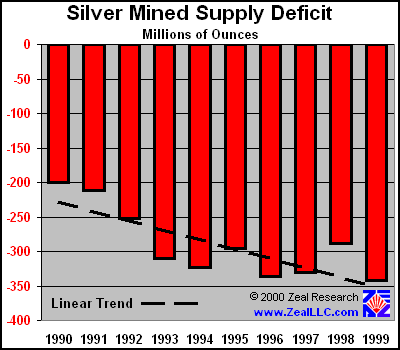
This mined supply deficit, as any freshman economics major could discern, is exceedingly bullish for the price of silver. Most industrial and photographic applications of silver are destructive. It is not cost effective, very difficult, or impossible to retrieve the silver used in most devices and silver applications. That silver is effectively gone from the market forever. With deficits ballooning this rapidly, world inventories are shrinking dramatically to make up for the shortfall in mined silver the world consumes each year. As the global metals markets can be an incredibly secretive and incestuous little world, it can be difficult to get solid numbers on world silver inventory levels. Some estimates indicate that global stocks of silver may only be a few hundred million ounces, or less than a single year’s deficit! If this is the case, we WILL all know about it in the next 12 months, because the moment the physical silver shortfall in mining production is not augmented by private and public sector silver sales, the price will leap up, exhibiting all its historical fury and violence at being long suppressed.
As the motivations, methodology, and desired outcome of the gold carry trade and gold suppression scheme employed to prop up fiat currencies and global stock markets have been exposed by many brilliant analysts, silver ALSO appears to be manipulated over the last five years. The primary motivation for suppressing silver is probably peripheral to gold. If silver rose dramatically in price, it would inevitably draw attention to the gold market and increase gold physical demand. If gold physical investment demand (not paper derivatives) increases substantially, it will break the backs of those entities short thousands of tons and many years total global production of the metal. Although out of the scope of this essay, the evidence of short side manipulation of the silver market is quite compelling. Gold Eagle has many excellent essays on the subject. The lionheart of the silver world, a man who will no doubt one day be hailed as a prophet, is Ted Butler. Mr. Butler has conducted much outstanding research on the silver markets and continues to fearlessly confront the silver shorts. If you are interested in investigating silver manipulations and chicanery further, I highly encourage you to search for Ted Butler on Gold Eagle or visit his website, www.butlerresearch.com.
From a historical valuation perspective, and from the crucial supply and demand perspective, silver appears to be dramatically undervalued and set for a massive leap in price. It is a textbook contrarian play, and the great contrarian Warren Buffet purchased a VAST amount of silver a few years ago. Being a contrarian requires great courage, as investment purchases are made when everyone else spurns an asset and holds it in contempt and derision. It is, however, the ULTIMATE investment strategy. In silver, there is an anomalous current opportunity to buy an asset that has withstood the grueling six millennia test of worth… at its lowest real prices in over thirty years. Like every other asset valuation in history, silver prices are cyclical and will inevitably test new historical highs as the next commodity bull market begins. With the CRB commodity index at multi-year highs, crude oil eclipsing Gulf War levels, gold ready to explode, and even some incorrigible equity bulls whispering the naughty “i” word (inflation), the bright light of investor sentiment will likely soon settle on silver. When the rest of the market figures out what a good deal it is (or global inventories run out) the price will EXPLODE like a fusion bomb. Buy cheap sell stratospheric!
The lagrimas de la luna WILL once again shine brightly, and global investors will place silver back on the revered pedestal from which the ancient Incans practically worshipped the amazing metal.
Adam Hamilton, CPA September 8, 2000
![]()